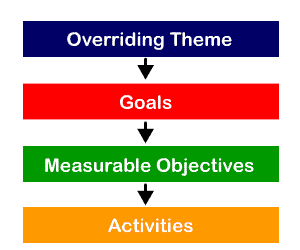- OU Homepage
- Search OU
- OU Social Media
- The University of Oklahoma
Goals, Objectives, and Activities
This KnowledgeBase archive includes content and external links that were accurate and relevant as of September 30, 2019.

The meaning and use of goals and objectives is often misunderstood or used incorrectly. Successful grant seekers win grant awards because they delineate project goals clearly, specify their objectives, and define project activities succinctly.
Goals
Goals, derived from the grant seekers needs assessment, are general statements of conditions the grant seeker would like to have become reality. Goals bridge the gap between what the needs are and what the proposed idea is trying to accomplish providing general direction for the organization to work toward. Goals reflect desired outcomes. They are not actual outcomes.
Objectives
Objectives are concerned with either performance, product, or process. Being specific, objectives identify a desirable change that is measurable and achievable within the project's timeframe. An objective relates directly to a need and has six parts.
1) When: The date by which change should occur 2) Who: The target population to be changed - quantify where possible 3) What: The desirable, observable, and measurable change to occur among the target population 4) How: The program or treatment to cause a change 5) Criterion: Determining the attainment of the change, a measuring device 6) Level of Success: Specific index of estimated achievement of change
Click on the Performance Objectives Worksheet for a guide on writing objectives.
Activities
Activities comprise the plan of operation for the project. In a detailed and concise way, they describe how each objective will be achieved. The Activities description is a key part of the grant proposal. For each objective, the activity will describe who, what, when, why, how, how many, and budget.
Source:
Belinda Biscoe, Ph.D., College of Continuing Education, University of Oklahoma, Norman, OK
The contents of this website were developed under a grant from the U.S. Department of Education and are intended for general reference purposes only. However, those contents do not necessarily represent the policy of the U.S. Department of Education or the Center, and you should not assume endorsement by the Federal Government. Some resources on this site require Adobe Acrobat Reader. This website archive includes content and external links that were accurate and relevant as of September 30, 2019.
